Crew Dragon Launch A Success For NASA And SpaceX
A successful launch for SpaceX and NASA and a successful beginning to the return of American manned spaceflight.
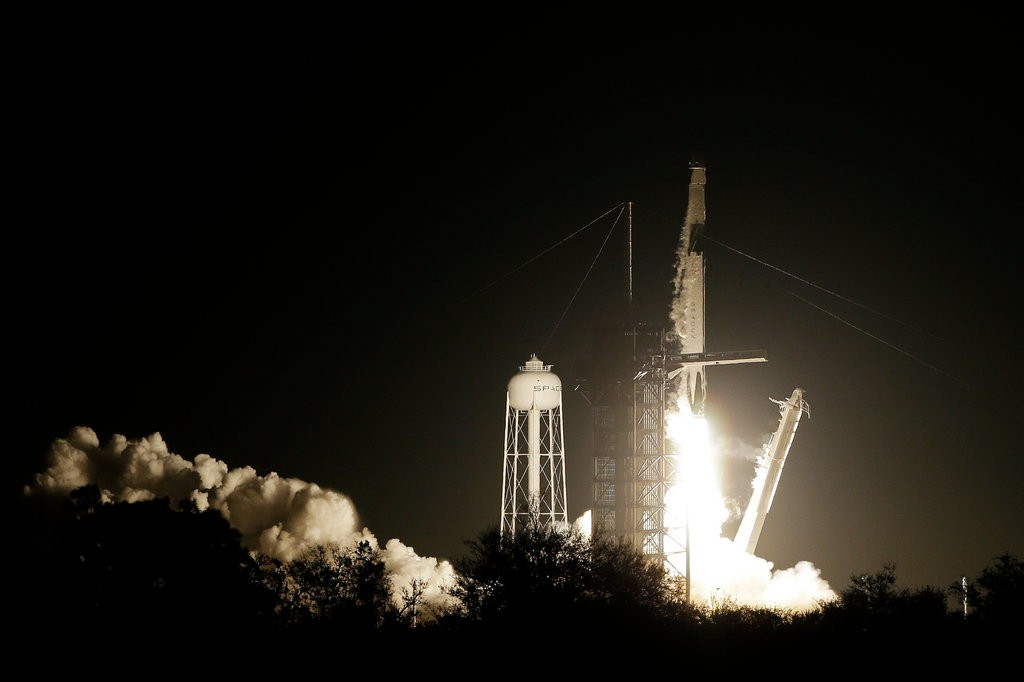
Early Saturday morning, SpaceX launched the Crew Dragon, which will eventually serve as a transport vehicle to get American astronauts to the International Space Station, in what appears by all accounts to have been a successful start to a crucial test mission:
The first American spacecraft capable of carrying astronauts since the retirement of the space shuttles launched early Saturday. A successful mission could put NASA and the United States on the cusp of a renewed era of human spaceflight.
There were no people on this demonstration flight, a SpaceX vehicle called Crew Dragon. As lightning sparked in distant skies, the spacecraft lifted off at the appointed time, 2:49 a.m. Eastern Time, from NASA’s Kennedy Space Flight Center in Florida. Within 10 minutes the capsule was in orbit, headed toward a Sunday morning rendezvous with the International Space Station.
“Tonight was a big night for the United States of America, a great night for NASA,” Jim Bridenstine, the NASA administrator, said during a news conference after the launch.
The launch was also an important step for the goals of Elon Musk, who founded SpaceX in 2002 and who says the objective of the company is to send people to space and eventually Mars. “It’s been 17 years to get to this point,” said Mr. Musk.
He described himself as emotionally exhausted. “But it worked,” Mr. Musk said of Crew Dragon. “So far.”
To date, the company has sent into space only satellites and cargo (and one Tesla sports car). “We still haven’t launched anyone yet, but hopefully, we will later this year,” Mr. Musk said. “So that would definitely be a culmination of a long dream for a lot of people, me and a lot of people at SpaceX.”
For the past eight years, NASA has been paying for rides on Russian spacecraft to get its astronauts to and from the International Space Station. Instead of developing and operating its own replacement for the space shuttles, NASA has instead turned to private companies to provide that service. In 2014, the space agency awarded two contracts, to SpaceX and to Boeing.
The mission that launched Saturday, known as Demo-1, is an end-to-end test of the spacecraft from launch to docking at the International Space Station to re-entering over the United States and splashing down in the Atlantic Ocean.
The capsule is to arrive at the space station on Sunday, about 27 hours after launch. Unlike earlier SpaceX missions that took cargo to the space station, which approached from below and was then grabbed by the station’s robotic arm, the Crew Dragon capsule will approach from the front and autonomously dock.
After five days at the station, it is scheduled to leave on March 8..
Mr. Musk said the most critical portions of the mission are the docking and the re-entry. The Crew Dragon’s top half has a more complex shape compared with an earlier version of SpaceX’s capsule that only carries cargo. That could cause it to tumble in the atmosphere.
“I think it’s unlikely,” Mr. Musk said. “We’ve run simulations a thousand times. But this is a possibility.”
The capsule can seat up to seven astronauts, although the early flights will not fill to capacity. For this demonstration flight, one of the four seats is occupied with a sort of artificial person — what NASA calls an A.T.D. or “anthropomorphic test device” — which is wearing a SpaceX spacesuit. The device includes sensors to measure forces and accelerations that a person would experience on the trip.
The SpaceX engineers named it Ripley, after the heroine in the Alien movies played by Sigourney Weaver. The Ripley dummy was accompanied by a plush globe intended to signal when the capsule’s occupants became weightless. Video footage in a tweet by Mr. Musk showed the toy lifting from its seat during orbit.
It is also carrying 400 pounds of cargo as well as inserts that simulate the mass of a more completely-filled capsule. Engineers on the ground will use information from the flight to understand how the spacecraft responds to being filled.
NASA officials say that they expect that not everything will work perfectly; the purpose of the demonstration flight is to identify potential problems, and fix them, before putting people aboard.
More from Space.com
CAPE CANAVERAL, Fla. — The United States may have just taken a big step toward human spaceflight self-sufficiency with a first-of-its kind launch by SpaceX.
SpaceX’s Crew Dragon capsule embarked on its first test mission to the International Space Station early this morning (March 2), launching atop a Falcon 9 rocket from NASA’s Kennedy Space Center (KSC) here on the Space Coast.
Nobody is aboard Crew Dragon on this six-day flight, known as Demo-1, save a sensor-laden dummy astronaut named Ripley in an apparent nod to the sci-fi film “Alien.” But if all goes according to plan with Demo-1 and a subsequent emergency-escape test, SpaceX will use the capsule to ferry two astronauts to the orbiting lab as early as this July.
That milestone will be huge: Astronauts haven’t launched to orbit from American soil since NASA grounded its space shuttle fleet in July 2011. Ever since then, the nation has been dependent on Russian Soyuz rockets and spacecraft to ferry astronauts to and from the space station — at a cost, most recently, of about $80 million per seat.
The two-stage Falcon 9 rocket lifted off this morning at 2:49 a.m. EST (0549 GMT), rising into the dark pre-dawn skies from KSC’s historic Launch Pad 39A — the site of the last crewed American orbital spaceflight, the STS-135 mission of the space shuttle Atlantis.
“It’s a truly exciting time,” KSC Director Bob Cabana, a former astronaut who launched three times from 39A on shuttle missions, told reporters here yesterday (March 1). “I can’t wait to see crews on top of that rocket.”
About 10 minutes after liftoff, the Falcon 9’s first stage came back to Earth, acing a touchdown on the SpaceX drone ship “Of Course I Still Love You,” which was stationed off the Florida coast. One minute later, Crew Dragon separated from the rocket’s second stage and began making its own way to the space station
SpaceX has been developing Crew Dragon under a $2.6 billion commercial-crew deal, which NASA awarded the company in 2014. Aerospace giant Boeing got a deal then, too: $4.2 billion to get its CST-100 Starliner capsule ready to fly.
At the time, NASA officials said they hoped to have one or both of these vehicles operational by the end of 2017.
Crew Dragon is an advanced, updated version of SpaceX’s Dragon cargo vehicle, which has flown 16 robotic resupply missions to the International Space Station (ISS) for NASA to date. But there are some important differences.
For starters, Crew Dragon has windows, seats (up to seven can be installed), life-support and environmental-control systems, touch-screen displays, and an emergency-escape system. This latter feature, which is designed to get astronauts out of harm’s way in case of a problem during launch, consists of eight SuperDraco thrusters built into the capsule’s body.
In addition, Crew Dragon’s solar panels are built into its trunk, and the capsule docks directly with the orbiting lab. The cargo version, by contrast, sports traditional deployable solar arrays, and it’s grappled by the ISS’s huge robotic arm.
(…)
Demo-1 is a shakeout cruise. The mission is designed to put all of Crew Dragon’s many systems through their paces in space to make sure the capsule is ready to take astronauts up and bring them down safely.
“We instrumented the crap out of this vehicle. It’s got data, sensors everywhere,” Kathy Lueders, manager for NASA’s Commercial Crew Program, said during a pre-launch news conference here at KSC Thursday (Feb. 28).
Some of those sensors were fitted to the “anthropomorphic test device” Ripley, which was named after Ellen Ripley from the “Alien” movie franchise.
“The goal is to get an idea of how humans would feel in her place, basically,” SpaceX Vice President of Build and Flight Reliability Hans Koenigsmann said Thursday. “I don’t expect, actually, a lot of surprises there, but it’s better to verify — make sure that it’s safe and everything’s comfortable for our astronauts going on the next flight of the capsule.”
If all goes according to plan, Crew Dragon will arrive at the ISS tomorrow morning (March 3), docking autonomously at about 6 a.m. EST (1100 GMT). The capsule will deliver about 400 lbs. (180 kilograms) of supplies to crewmembers aboard the orbiting lab — but no scientific experiments.
“We want to focus on the test objectives,” David Brady, assistant program scientist for the ISS, told reporters here yesterday. Having scientific gear aboard could compromise that focus, he explained.
Crew Dragon will probably end up toting about 220 lbs. (100 kg) of experiments on fully operational missions, he added. That may not seem like a lot, but a lot isn’t needed; cargo Dragon and other freighters will continue to carry the bulk of the ISS’s science load, Brady said.
Demo-1 will come to an end on Friday (March 8). Crew Dragon is scheduled to depart the orbiting lab at around 2:30 a.m. EST (0730 GMT) that day and splash down in the Atlantic Ocean, not far from the Florida coast, about 6 hours later. (Cargo Dragons come down in the Pacific. But SpaceX wants to start processing landed Crew Dragons at the company’s Florida facilities quickly, which explains the shift in splashdown sites, Koenigsmann said.)
Here’s some video of the launch, as well as the SpaceX webcast that aired early this morning which includes introductory material, the actual coverage of the launch begins at about the 37-minute mark:
LIFTOFF! The next big leap in a new chapter of U.S. human spaceflight systems has left the pad. @SpaceX’s #CrewDragon demo flight will be the 1st commercially-built & operated American spacecraft designed for humans to dock at the @Space_Station. Watch: https://t.co/Fm5NQSfAXJ pic.twitter.com/YoiOf67kQL
— NASA (@NASA) March 2, 2019
Earth floats gently in zero gravity pic.twitter.com/XUH3KeDPVe
— Elon Musk (@elonmusk) March 2, 2019
SpaceX Crew Dragon recap https://t.co/MmQmctxRSo
— Elon Musk (@elonmusk) March 2, 2019
As I said yesterday, today’s launch and the mission that will take place over the next several days is important for both NASA and SpaceX because it is the first step toward establishing a means to get astronauts to the International Space Staton without having to rely on the Russians and their Soyuz spacecraft which, while reliable, is still based on technology from the Cold War and, more importantly, subject to being called off without notice depending on the always precarious state of relations between the United States and Russia. If SpaceX and NASA can pull this off then we’ll be able to get our men and women, and those of allied nations, to the ISS without having to pay the Russians for the privilege. Additionally, there would obviously be something of a morale boost that would come from the return of an American manned spaceflight program for the first time since the Space Shuttle program ended in 2011.
The commercial flight programs being developed by SpaceX, Boeing, and other companies isn’t the only avenue that NASA is working on in the effort to take the manned space program into the 21st Century. For longer-term missions, it’s working on the Orion spacecraft, which is designed for taking astronauts into higher orbits than the ISS and, eventually missions to the Moon and elsewhere, including, eventually, a mission to Mars. Orion had its first unmanned test flight back in 2014 and it was considered a complete success. Since then, the system has been undergoing further testing and development with the goal of the first manned test flight taking place in the early 2020s. If all goes as planned, this is the system that would take Americans back to the Moon first the first time since Apollo 17 in 1972. It’s admittedly a slow-moving schedule, but it does appear to be moving forward.
In any case, the next step in the Crew Dragon test will take place early Sunday morning, at roughly 6:00 am Eastern time. As with this morning’s launch, you can watch the coverage, which will begin around 3:30 am Eastern, live on SpaceX’s Webcast. After that, the Crew Dragon will remain attached to the ISS until the middle of the week at which point the final portion of the test flight, a return to Earth, is scheduled to take place.

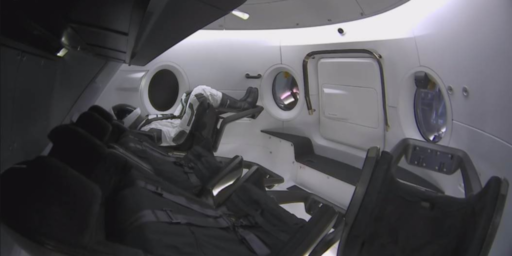
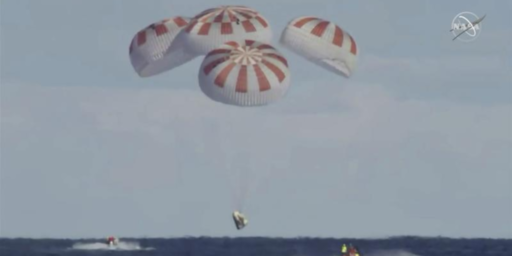
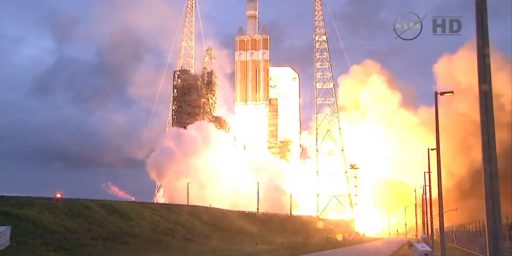
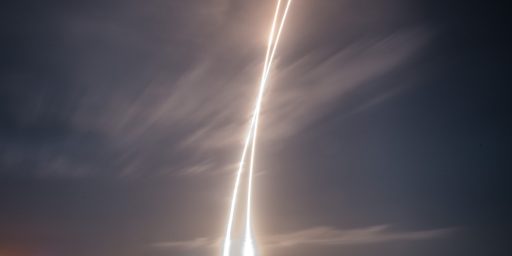
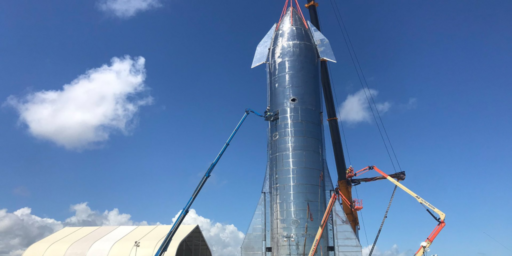
It’s so wonderful to read news about something that isn’t about the daily shitstorm that politics has become.
It was an fun launch to see streamed. Wish I’d been there.
@Teve:
Don’t tell them, but Elon Musk is South African.
Good on you, Dougles. You can ask those +1.6 Watts per m/2 across the planet’s surface to hold their photons while you load them onto your starships to dump into space.
Magic billionaires to the rescue.
Lol WUT. 😛 😛 😛
@Kathy: a month or two ago Trump asked at nasa if they could do a mission to Mars in his first term. Crediting any success in space to that idiot….